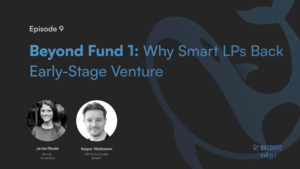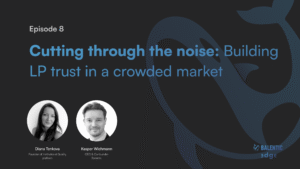
Defence investing has quietly moved from exclusion to opportunity – reshaping private equity, venture capital, infrastructure, and private credit.
In this special solo edition of Balentic Edge, Kasper Wichmann, CEO and founder of Balentic, explores the drivers behind defence’s re-emergence: shifting geopolitics, rising capital flows, and new technology layers from satellites to cybersecurity.
Kasper unpacks the evolving manager landscape, LP risks and opportunities, ESG considerations, and why private markets, not public equities, are at the forefront of this transformation.
If you’re an LP, GP, or private markets professional, this episode offers a clear framework for approaching defense responsibly while capturing long-term value.
Special Edition. From Taboo to Opportunity: Defence Investing in Private Markets
Host: Kasper Wichmann
Keywords:
Defence
Private Markets
LP Strategy
Transcript
Kasper Wichmann
Welcome to Balentic Edge, conversations that matter in private markets. I’m your host Kasper – investor, entrepreneur and founder of Balentic. On this show, we explore the people, strategies and ideas shaping private markets today, from GPs building tomorrow’s funds to LPs allocating in a shifting landscape. This episode is brought to you by Orca, an AI-driven compliant platform connecting the right GPs with the right LPs – smarter matches, faster decisions and better outcomes.
Today is a special edition where we – based on my recent blog post series on defense – are diving into one of the most striking transformations in private markets: the rise of defense investing. What was once taboo, relegated to ESG exclusion lists alongside tobacco and gambling, has become a strategic theme cutting across private equity, venture capital, infrastructure, and private credit. In this episode, I’ll walk you through how defense investing has evolved, what it looks like today, and what LPs and GPs need to know if they’re considering exposure.
Private capital is quietly reshaping the global defense landscape. The drivers are clear: Russia’s invasion of Ukraine, rising U.S.-China tensions, and a European policy reset. The numbers tell the story. In early 2025 alone, more than $4 billion flowed into defense-aligned private market deals. That already exceeded all of 2023 and almost all of 2024.
The investment thesis has shifted. It’s not just about weapons; it’s about sovereignty, resilience, and the technology layers underpinning modern defense. Today’s defense sector looks nothing like the old industrial complex. Instead of tanks and jets, think sensors, satellites, cybersecurity, and software. The modern battlefield increasingly resembles a technology lab. Autonomous systems, AI-enabled decision support, and space-based infrastructure are attracting private capital in ways unimaginable just a decade ago. Governments are pushing for localization and redundancy in supply chains, opening the door for private capital to back modernization initiatives in both industrial and digital defense.
So why is this playing out in private markets rather than public equities? The answer is speed, access, and alignment. Private companies are where much of the cutting-edge technology originates. Private equity and venture capital bring agility, specialist expertise, and the long-term horizons needed for defense development cycles. They also bring the regulatory fluency—navigating export controls, procurement, and security clearance requirements—that founders and governments rely on.
The manager landscape has two poles. On one side, specialists such as Arlington Capital, AE Industrial, and Veritas. These firms bring clearance capabilities and deep procurement expertise. On the other side, generalists like Carlyle, Advent, KKR, and Blackstone. They bring scale, operational playbooks, and cross-sector expertise. For LPs, it’s not either–or. A balanced portfolio may combine specialist depth with generalist breadth.
From the LP perspective, defense offers real attractions—stable, often inflation-linked government contracts, downside protection, and diversification in uncertain times. But risks loom large. Customer concentration is high. Development cycles are long. And reputational considerations are more complex than in almost any other sector. Diligence must go deeper than usual. Export licenses, security clearance, technology obsolescence, and the details of government contracts all need scrutiny.
ESG frameworks are shifting from blanket exclusions to nuance. Some institutions still exclude defense entirely. Others allow exposure to NATO-aligned technologies, dual-use innovations, or purely defensive capabilities. In ESG, social stability and protection of democratic institutions is being reinterpreted. Defense can now be seen as enabling peace and resilience, not just conflict, but this requires sharper governance. Enhanced disclosure, end-use monitoring, and clear exclusions remain non-negotiable.
Defense investing is not only about equity. Infrastructure and private credit are becoming major channels. Infrastructure investors are backing hardened data centers, secure comms networks, and satellite ground stations – often with sovereign‑grade contracts and inflation‑linked returns. Private credit fills the funding gap where banks hesitate. Aerospace suppliers and cybersecurity contractors need working capital across long procurement cycles. Specialist credit managers are stepping in with milestone‑based loans tied directly to government contracts.
The United States remains the deepest and most liquid market, but Europe is catching up. Defense spending is rising sharply, industrial policies are tightening, and mid‑market consolidation is accelerating. Scandinavia, France, and Germany are particularly active, with cross‑border cooperation attracting both capital and government backing. The bottom line: LPs should diversify geographically and by vintage, since procurement cycles and policy risks don’t follow market calendars.
Venture capital in defense is experiencing a renaissance. Deal value has increased 18‑fold over the past decade. Why? Two flywheels. Government pull: programs that engage early‑stage firms and fund prototypes directly. Commercial push: dual‑use technologies with broad TAM: AI platforms, autonomy, space infrastructure. The success of Palantir, SpaceX, and Andoril shows that defense‑backed ventures can scale and exit. This isn’t just grant tech anymore.
Looking ahead, the frontier includes quantum computing, hypersonics, biotechnology, and expanded space capabilities. These aren’t just science projects – they’re attracting serious capital. Exit strategies are also broadening. Traditional primes remain buyers, but tech giants: Microsoft, Amazon, Google – are now acquiring defense capabilities. Public markets are more receptive, and secondaries are developing as specialist funds mature. For LPs, that means more liquidity options than ever.
So what should LPs do? Three steps. First, establish a clear policy framework: define what’s in, what’s out, and how defense exposure aligns with stakeholder expectations. Second, map existing exposure – defense‑adjacent assets often hide inside tech, infrastructure, or industrial allocations. Third, build implementation discipline: evaluate managers for clearance capabilities, procurement expertise, and compliance systems. Diversify across subsectors, geographies, and vintages. And always ask the hard diligence questions: Who are your government customers? What clearances do you hold? How do you monitor export licenses? How do you prevent misuse of technology?
Defense investing has transformed from exclusion to opportunity. For private markets, it represents a generational theme spanning venture, buyout, infrastructure, and credit. Done thoughtfully, it can deliver attractive returns, stable revenues, and thematic alignment with national security. But it requires sharper diligence, clearer policies, and higher governance standards than most sectors. For LPs, the question is no longer whether defense belongs in institutional portfolios – it’s how to approach it responsibly and effectively.
Kasper Wichmann
Thank you to our listeners for tuning in to Balentic Edge. I hope you enjoyed the conversation. If you did, please hit follow on Spotify or Apple, or subscribe on YouTube. And consider sharing this episode with a friend or a colleague. Do you have feedback or questions? I’d love to hear from you. Connect with me on LinkedIn. This episode was brought to you by Orca—helping GPs reach the right LPs and LPs discover the right funds. Learn more at balentic.com/orca. Thanks again for listening, and until next time, stay illiquid.
Finally, a small disclaimer. The views expressed in this podcast are solely those of the host and guests and are provided for informational purposes only. They do not represent the views of any affiliated organizations, employers, or entities. Nothing discussed should be construed as investment, legal, tax, or business advice. Any reference to specific funds, companies, or investment strategies is purely illustrative and does not constitute an offer, solicitation, or recommendation to buy or sell any security or financial instrument. Listeners should consult their own professional advisors before making any investment or financial decisions.
Disclaimer: The views expressed in this podcast are those of the speakers and do not necessarily reflect those of Balentic ApS (“Balentic”). This podcast may contain forward-looking statements which are subject to risks and uncertainties. It is for informational purposes only and does not constitute investment or other professional advice, or an offer to buy or sell any financial instrument.
More from Balentic Edge
Balentic Edge
Sign up to keep up to date with the latest news and updates.
© 2025 Balentic ApS. CVR: 44034255. All rights reserved.
Privacy Policy | Terms of Service
The Balentic website and Orca are, and are expected to continue to be, under development. Consequently, some of the features described in this Overview and/or on the website may not yet be available or may work differently. Some features may furthermore not be available to all users.


